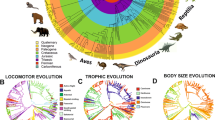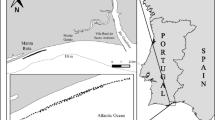Abstract
The relation of skeleton weight to body weight with increasing size is compared for aquatic and terrestrial vertebrates. Due to the buoyancy of water, the skeleton weights of aquatic vertebrates (fishes and whales) vary in nearly direct proportion (exponent 1.0) to body weight; while the skeletons of terrestrial vertebrates occupy an increasingly greater proportion of total body weight as size increases (exponent greater than i. i) due to the necessity of supporting their weight on land.
Similar content being viewed by others
References
Bakker, R. T. 1975. Dinosaur renaissance. Sci. Amer. 232: 58–79.
Currey, J. D. 1967. The failure of exoskeletons and endoskeletons. J. Morph. 123: 1–16.
Davis, D. D. 1962. Allometric relationships in lions vs. domestic cats. Evolution 16: 505–514.
Donaldson, H. H. 1919. Quantitative studies on the growth of the skeleton in the albino rat. Amer. J. Anat. 26: 237–314.
Galileo, G. L. 1638. Dialogues concerning two new sciences, Transl. by H. Crew and A. De Salvio (1933), Macmillan, New York.
Gould, S. J. 1971. Geometric similarity in allometric growth: a contribution to the problem of scaling in the evolution of size. Amer. Nat. 105: 113–136.
Hill, A. V. 1950. The dimensions of animals and their muscular dynamics. Sci. Progr. 38: 209–229.
Kayser, C. & Heusner, A. 1964. Etude comparative du métabolisme énergétique dans la série animale. J. Physiol. 56: 489–524.
Lockyer, C. 1976. Body weights of some species of large whales. J. Cons. Int. Explor. Mer 36: 259–273.
McMahon, T. 1973. Size and shape in biology. Science 179: 1201–1204.
Niimi, A. J. 1974. Relationship between ash content and body weight in lamprey (Petromyzon marinus), trout (Salmo gairdneri) and bass (Micropterus salmoides). Copeia 1974: 794–795.
Prange, H. D. & Christman, S. P. 1976. The allometrics of rattlesnake skeletons. Copeia 1976: 542–545.
Reynolds, W. W. & Karlotski, W. J. 1977. The allometric relationship of skeleton weight to body weight in teleost fishes: a preliminary comparison with birds and mammals. Copeia 1977: 160–163.
Romer, A. S. 1967. The Vertebrate Story. Univ. Chicago Press, Chicago.
Schmidt-Nielsen, K. 1972. How Animals Work. Cambridge Univ. Press, Cambridge.
Schultz, A. H. 1962. The relative weights of the skeletal parts in adult primates. Amer. J. Phys. Anthropol., n.s., 20: 1–10.
Szarski, H. 1964. The structure of respiratory organs in relation to body size in Amphibia. Evolution 18: 118–126.
Thompson, D. W. 1942. On Growth and Form. Cambridge Univ. Press, Cambridge.
Ultsch, G. R. 1974. The allometric relationship between metabolic rate and body size: role of the skeleton. Amer. Midl. Nat. 92: 500–504.
Author information
Authors and Affiliations
Rights and permissions
About this article
Cite this article
Reynolds, W.W. Skeleton weight allometry in aquatic and terrestrial vertebrates. Hydrobiologia 56, 35–37 (1977). https://doi.org/10.1007/BF00023283
Received:
Published:
Issue Date:
DOI: https://doi.org/10.1007/BF00023283




